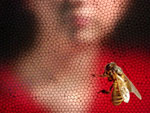A magazine where the digital world meets the real world.
On the web
- Home
- Browse by date
- Browse by topic
- Enter the maze
- Follow our blog
- Follow us on Twitter
- Resources for teachers
- Subscribe
In print
What is cs4fn?
- About us
- Contact us
- Partners
- Privacy and cookies
- Copyright and contributions
- Links to other fun sites
- Complete our questionnaire, give us feedback
Search:
Life in the Undergrowth: Bee Faces

How hard is it to recognize faces? We do it naturally but then humans are pretty smart with pretty big brains. Computers find it pretty difficult though are now much better than they were thanks to the efforts of computer scientists. How about insects? How smart are they with their minature brains? Honeybees for example only have 1 neuron for every hundred in your brain. They need pretty slick abilities for recognizing patterns to survive though. They need to be able to pick out the right flowers to collect nectar. Are honeybees capable of recognizing human faces as well as flowers? What do you think?
Behavioural Ecologists at Queen Mary, Cambridge and Mainz set up a simple face recognition experiment based on one used with humans to find out. Black and white photographs of a target human face were mixed in among other human faces on a screen. The bees were rewarded with a sugar solution if they identified the target face and punished with a drop of bitter quinine solution if they were distracted by one of the other faces.
A good experiment has to rule out possibilities other than the one you are interested in too. To make sure that the bees did not simply make a beeline for the same area of the screen each time they were released, the photographs were moved so that the bees could not just learn where the rewards were.
The results showed that the bees were capable of recognizing faces even up to two days later so had built up a long-term memory. Even though bees evolved their pattern recognition skills for flower recognition those skills are incredibly flexible and work just as well on other things like faces.
Results like this matter to computer scientists interested in both creating artificial intelligences generally and developing face-recognition systems. It shows that face recognition doesn't need human level intelligence or specialised neuronal hardware. Understanding the way bees do it will help develop better computer face recognition systems.


